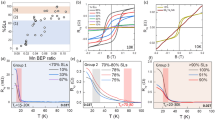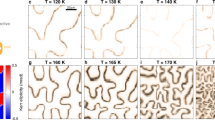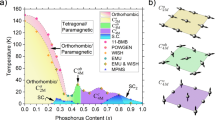Abstract
MAGNETISM and superconductivity are manifestations of two different ordered states into which metals can condense at low temperatures. In general these states are mutually exclusive1; they do not coexist at the same place in a sample. The study of the interplay between these properties has recently been revitalized by the discovery2,3 of a class of compounds with formula RNi2B2C (where R is a rare-earth element) which are both antiferromagnetic and superconducting at sufficiently low temperature4. It has been suggested5 that magnetic and superconducting order can coexist in these materials on an atomic scale. Here we use small-angle neutron scattering to study the structure of the superconducting vortex lattice in ErNi2B2C. Our results show that the development of magnetic order causes the vortex lines to disorder and rotate away from the direction of the applied magnetic field. This coupling of superconductivity and magnetism provides clear evidence for microscopic coexistence of magnetic and superconducting order, and indicates that magnetic superconductors may exhibit a range of unusual phenomena not observed in conventional superconductors.
This is a preview of subscription content, access via your institution
Access options
Subscribe to this journal
Receive 51 print issues and online access
$199.00 per year
only $3.90 per issue
Buy this article
- Purchase on Springer Link
- Instant access to full article PDF
Prices may be subject to local taxes which are calculated during checkout
Similar content being viewed by others
References
Matsubara, T. & Kotani, A. (eds) Superconductivity in Magnetic and Exotic Materials (Springer, Berlin, 1984).
Nagarajan, R. et al. Phys. Rev. Lett. 72, 274–277 (1994).
Cava, R. J. et al. Nature 367, 252–253 (1994).
Cho, B. K., Canfield, P. C. & Johnston, D. C. Phys. Rev. B52, R3844–R3847 (1995).
Eisaki, H. et al. Phys. Rev. B50, 647–650 (1994).
Cho, B. K. et al. Phys. Rev. B52, 3684–3695 (1995).
Zarestky, J. et al. Phys. Rev. B51, 678–680 (1995).
Sinha, S. K. et al. Phys. Rev. B51, 681–684 (1995).
Cubitt, R. et al. Nature 365, 407–411 (1993).
Keimer, B. et al. Science 262, 83–86 (1993).
Ullmaier, H., Zeller, R. & Dederichs, P. H. Phys. Lett. 44A, 331–332 (1973).
Kleiman, R. N. et al. Phys. Rev. Lett. 69, 3120–3124 (1992).
Gammel, P. L. et al. Phys. Rev. Lett. 72, 278–282 (1994).
Canfield, P. C., Bud'ko, S. L. & Cho, B. K. Physica C 262, 249–254 (1996).
Author information
Authors and Affiliations
Rights and permissions
About this article
Cite this article
Yaron, U., Gammel, P., Ramirez, A. et al. Microscopic coexistence of magnetism and superconductivity in ErNi2B2C. Nature 382, 236–238 (1996). https://doi.org/10.1038/382236a0
Received:
Accepted:
Issue Date:
DOI: https://doi.org/10.1038/382236a0
This article is cited by
-
Vortex lattices in type-II superconductors studied by small-angle neutron scattering
Frontiers of Physics (2011)
-
Magnetism and superconductivity in ErNi2B2C
Pramana (2002)
-
Flux line lattice symmetries in the borocarbide superconductor LuNi2B2C
Pramana (2002)
-
Vortex lattice transitions in YNi2B2C
Pramana (2002)
Comments
By submitting a comment you agree to abide by our Terms and Community Guidelines. If you find something abusive or that does not comply with our terms or guidelines please flag it as inappropriate.



